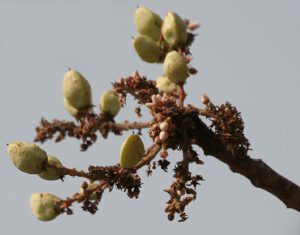
Boswellia has been used in connection with asthma, rheumatoid arthritis, ulcerative colitis, bursitis, and osteoarthritis.
Boswellia Click to listen highlighted text! Boswellia : Common name: Salai guggal. Botanical name: Boswellia serrata.
Studies have shown that boswellic acids have an anti-inflammatory action – much like the conventional nonsteroidal anti-inflammatory drugs (NSAIDs) used for inflammatory conditions. Boswellia inhibits pro-inflammatory mediators in the body, such as leukotrienes.
As opposed to NSAIDs, long-term use of boswellia does not appear to cause irritation or ulceration of the stomach. One small, controlled, double-blind trial has shown that boswellia extract may be helpful for ulcerative colitis.
The standardized extract of the gum oleoresin of boswellia is recommended by many doctors.
Historic Use:
In the ancient Ayurvedic medical texts of India, the gummy exudate from boswellia is grouped with other gum resins and referred to collectively as guggals. Historically, the guggals were recommended by Ayurvedic physicians for a variety of conditions, including osteoarthritis, rheumatoid arthritis, diarrhea, dysentery, pulmonary disease, and ringworm.
The Plant:
It is a moderate to large branching tree found in the dry hilly areas of India. When the tree trunk is tapped, a gummy oleoresin is exuded. A purified extract of this resin is used in modern herbal preparations.
Constituents:
The gum oleoresin consists of essential oils, gum, and terpenoids. The terpenoid portion contains the boswellic acids that have been shown to be the active constituents. Today, extracts are typically standardized to contain 37.5–65% boswellic acids.
Boswellia Dosage:
For rheumatoid arthritis or osteoarthritis, 150 mg of boswellic acids are taken three times per day. As an example, if an extract contains 37.5% boswellic acids, 400 mg of the extract would be taken three times daily. Treatment with this herb generally lasts eight to twelve weeks. In the one clinical trial to date, people with ulcerative colitis used 550 mg of the extract three times per day.
Precautions:
The herb is generally safe when used as directed. Rare side effects can include diarrhea, skin rash, and nausea. Any inflammatory joint condition should be closely monitored by a physician. At the time of writing, there were no well-known drug interactions.
You might also be interested in Borage and Meadowsweet.
